Safely Traveling in a Vehicle with Pets
Jan 10, 2019 Tracey Aston Pet Safety

We've all seen it – you're driving along and the next thing you know, the car in front of you has a dog with their head hanging out the window! This is the most common, and dangerous, way for a pet to travel in the car. While this might seem like a harmless habit, it's far from it! Allowing a pet to travel unrestrained, with their head hanging out the window can be extremely dangerous. The pet could see another animal and jump out of the window to chase it. In the unfortunate event of an accident, the pet can be thrown out of the window, or worse, pinned between two colliding vehicles. If a driver is forced to swerve to avoid an accident, they could not notice how close they are getting to telephone poles or other cars and the pet could be severely injured. Even an uneventful ride with a pet's head out of the car window poses risks to the pet's face, eyes, ears, mouth and nose from dirt and road debris. A flying piece of glass or broken stick could cause serious facial or eye injuries.
The second highest risk for pet injury is allowing the pet to move around the vehicle unrestrained. A pet parent may think their pet is well-behaved, and therefore the pet doesn't need to be secured while traveling. While a well-behaved pet reduces the risk of distracted driving, that won't stop them from being thrown in the event of a quick stop or accident. In the event of a collusion, not only is the pet in serious danger, so is the driver. An impact or sudden stop could potentially send a pet airborne and threw a window or windshield, or even into the driver! An unrestrained, large pet with momentum flying into the head of the driver could have absolutely deadly results.
The final risk is one many pet parents might not even realize, and that is a pet, even a restrained pet, should never be travelling in the front passenger side of the vehicle or in your lap while you're driving! Flip over the visor of any modern car, truck or SUV and you will see an airbag warning stating that children or those under a certain height and weight should not ride in the front seat due to the risk of an air bag deployment. Most pets don't sit as high as humans and depending on the size of the pet, may even sit closer to the airbag. An airbag can deploy in about 55 milliseconds, and depending on the vehicle, with a force of between 100 to 220 miles per hour. At that speed and force, there isn't enough reaction time to avoid air bag impact and the pet is at a huge risk for neck, chest, throat, head trauma and even death
Thankfully, there are many ways to safely include our pets in our outings. Depending on the size of your pet and vehicle, the safest way to travel with your pet will be either a seatbelt system or a crate, either enclosed or wired.
Seatbelt systems come in numerous and varied types, sizes, colors and costs. There are booster and lookout seats for smaller dogs and harness systems and click and clip seat belt attachments for larger dogs. All systems have one thing in common, they attach to the vehicles seat belt system by a loop in the harness or car seat for seat belts to click through. Click and clip attachments are medium length nylon strips, similar to a pet leash, that has a seat belt buckle attachment on one end to clip into the seat belt and a metal latch to clip to the back of a harness or safety seat. Never attach a click and clip attachment to a collar! Doing so could result in serious neck and throat injury to your pet in the event of an accident!
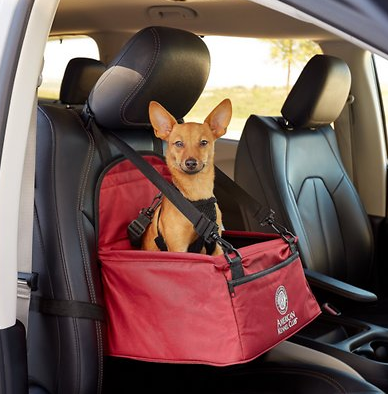
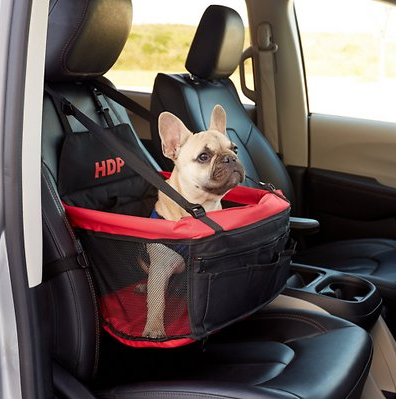
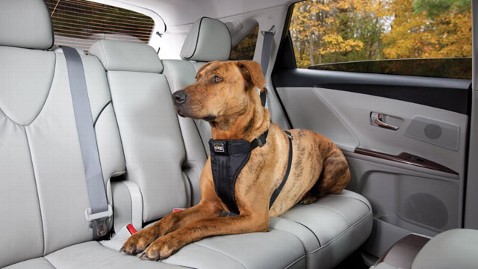
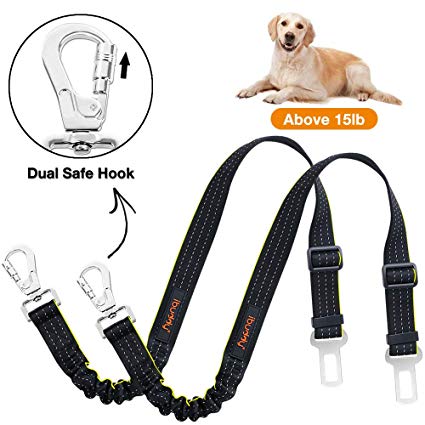
Crates are another safe travel options for our pets, especially cats. Smaller dogs and cats can safely travel in an enclosed crate with a lid, but the crate itself will still need to be secured by either a tether system or an attachment, such as a click and clip attachment. A pet in an unsecured crate is still at risk for injury during a quick stop, swerve or collision as the momentum will now send the pet and the crate airborne.

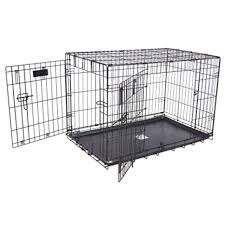
For larger vehicles, such as SUVs, that have the extra room, a large wire crate works best for large pets. The crate will allow a large pet to lie down comfortably and securely, which they may not be able to do in a standard size car seat. If you're using a large, wired crate, make sure the crate has 2 exits, one on the back and one on the side. In case of an accident, a door or back hatch may be jammed and you'll need another way to get the pet from the vehicle. As larger breeds are prone to joint issues, it might be a good idea to invest in a ramp to allow your pet to enter and exit an SUV without the extra stress on their joints. A ramp is also a pet friendly option for senior pets, who now may be having trouble jumping into a higher clearance vehicle.

In the case of an emergency, when a seat belt system or crate is not immediately available, attaching a leash to a regular harness and then closing the leash in a door can be used in a pinch. The leash MUST be attached to a harness and NOT a collar. This method should only be used as a temporary quick fix in an emergency situation.
Pets love to travel, spend time with their families and visit new places too! Minimizing risks and taking the steps to restrain and secure the pet will ensure they can safely enjoy their travel experience.
















